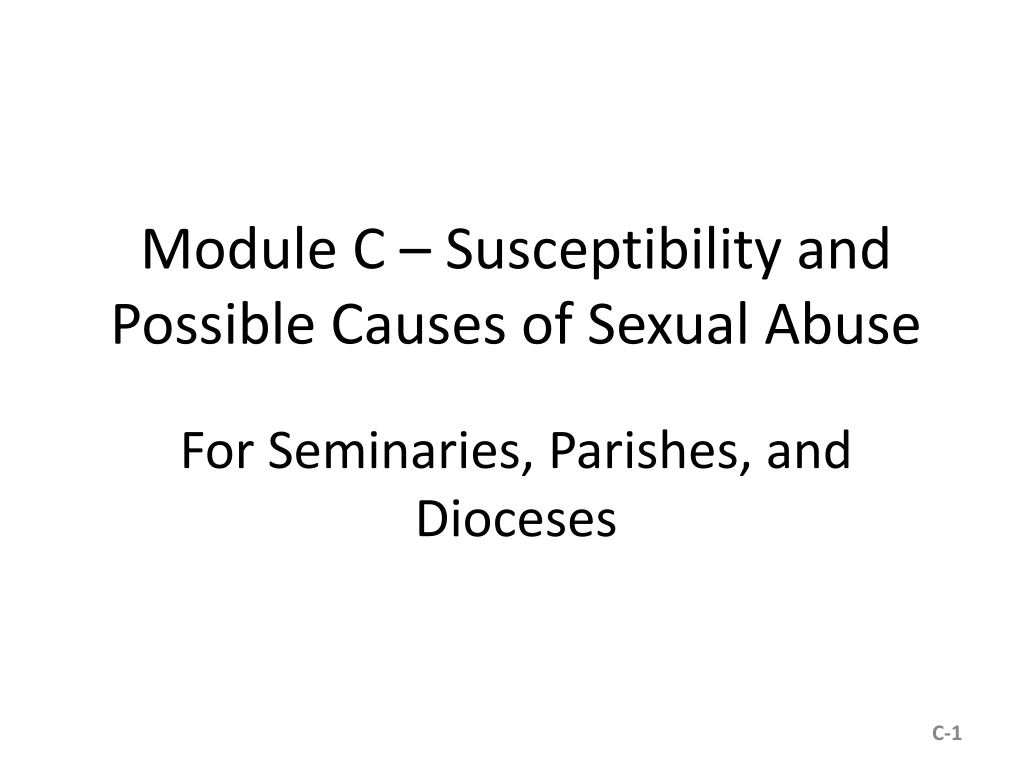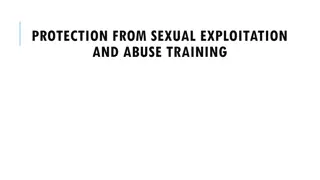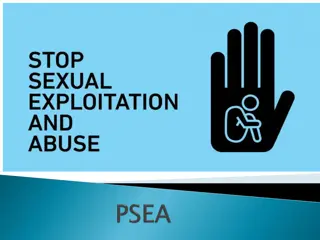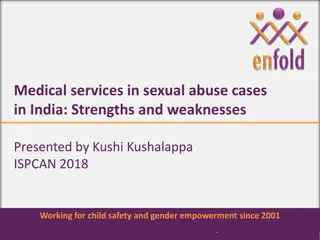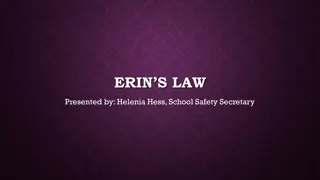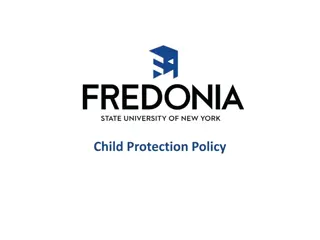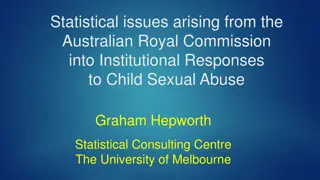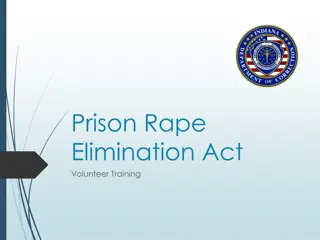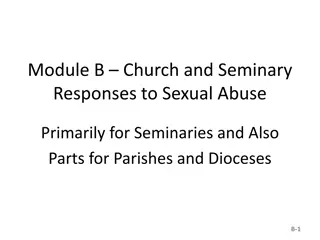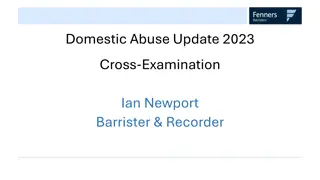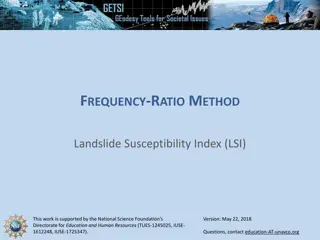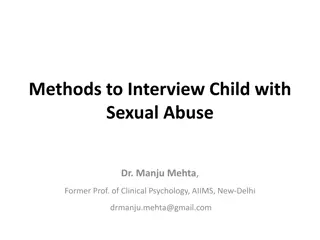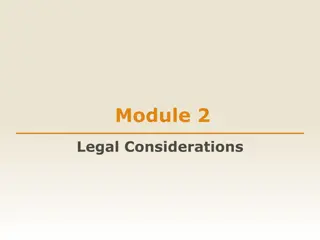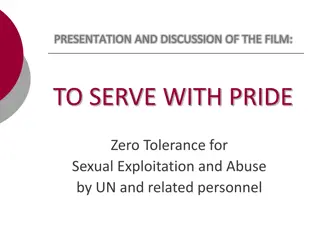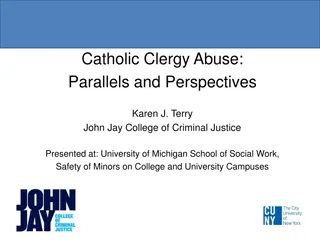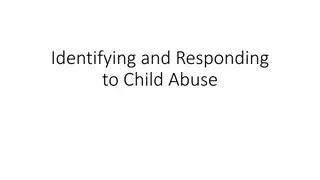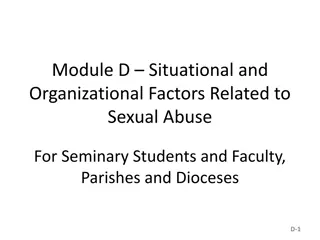Understanding Susceptibility and Causes of Sexual Abuse in Catholic Institutions
Exploring the susceptibility and possible causes of sexual abuse in seminaries, parishes, and dioceses. The research highlights factors contributing to abuse, including organizational, psychological, and situational elements. It emphasizes the importance of education for potential victims, abusers, and guardians to prevent abuse effectively.
Download Presentation

Please find below an Image/Link to download the presentation.
The content on the website is provided AS IS for your information and personal use only. It may not be sold, licensed, or shared on other websites without obtaining consent from the author. Download presentation by click this link. If you encounter any issues during the download, it is possible that the publisher has removed the file from their server.
E N D
Presentation Transcript
Module C Susceptibility and Possible Causes of Sexual Abuse For Seminaries, Parishes, and Dioceses C-1
Research Explaining Susceptibility and Possible Causes of Sexual Abuse of Minors by Catholic Priests C-2
Main Sources of Data Reports presented to the United States Conference of Catholic Bishops by the John Jay College Research Team, The City University of New York* The Causes and Context of Sexual Abuse of Minors by Catholic Priests in the United States, 1950-2010, March, 2011 The Nature and Scope of Sexual Abuse of Minors by Catholic Priests and Deacons in the United States, 1950- 2002, February 2004 * The two reports are based on data supplied by 97 percent of U.S. archdioceses and dioceses on all clergy accused of sexual abuse of minors C-3
Susceptibility and Possible Causes of Abuse Before examining factors that relate to sexual abuse, it is important to note that no single cause of sexual abuse of minors in the Catholic Church has been identified as a result of the John Jay research, nor is there a single cause in the general population However, it is critical to understand, for individual priests who abused minors, many organizational, psychological, and situational factors contributed to their susceptibility to perpetrate abuse C-4
Susceptibility, 2: Three Necessary Conditions for Abuse to Occur There must be a person who is motivated to commit the act of abuse There must be a potential victim There must be a lack of a capable guardian To reduce abuse, education of potential victims, potential abusers, and potential guardians is essential C-5
Susceptibility to Sexual Abuse, 3: Limits to Identifying Abusers Although factors creating susceptibility to sexual abuse may exist, this does not imply that its presence makes it possible to either - identify specific causes of the abusive behavior, or - identify specific individuals who will commit acts of abuse Rather, it means that some factors may be associated with the abuse of children, though these are often multifaceted and complex; in some men, but not in others, these factors may interact and lead to a greater predisposition to abuse C-6
Psychological Tests, 1 Priests who had abused minors could not be significantly differentiated on the basis of psychological tests from priests who had not abused minors Behavior is thought to arise from a combination of factors including: biology, genetics, psychology, environment, and life experience Nonetheless, there are several personality- based risk markers for clergy sexual abusers that merit further attention C-7
Psychological Tests, 2 Other possible risk markers for sexual abuse of minors include: Collectively, data suggest that the list of personality-based risk markers for clergy sexual abusers include the following: Elevations on these MMPI subscales: Need for Affection Social Imperturbability Imperturbability Inhibition of Aggression Elevations on these MMPI subscales: Denial of Social Anxiety Authority Problems Persecutory Ideas Amorality Over-controlled Hostility Note well: None of the primary scales show significant risk factors, and so any elevation on subscales should be interpreted with caution. C-8
Behavioral Explanations Clinicians and behavioral theorists observe the following impacts of childhood experience and learned behavior on adult lives If a youth or child is a victim of sexual abuse by an adult, his capacity for emotional attachment and sexual response as an adult may be impaired Early sexual experience is thought to have an influence on subsequent sexual behavior Low self-esteem and social isolation are considered to be associated with child sexual abuse C-9
Intimacy Deficits in Priests Accused of Sexual Abuse of Minors, 1 Intimacy deficits are weaknesses or difficulties in developing healthy emotional relationships with others Intimacy deficits increase susceptibility to deviant sexual behavior, due in part to lack of openness and honesty in relationships with mentors and peers In cohorts of priests ordained between 1940 and 1960, intimacy deficits were pronounced and sexual abuse of minors was most numerous C-10
Intimacy Deficits and Psychosexual Maturity, 2 In a 1971 study of priests, a lack of an integrated psychosexual maturity was identified as a major area of underdevelopment in priests Uncertainty about sexuality affected their sense of personal identity and made it difficult for them to accept and deal with the challenge of intimacy Sexual feelings were identified as a source of conflict and difficulty; much energy went into these feelings or into the effort to distract themselves from them Based on Loyola-Kennedy Study, 1971 (p. 50, Causes and Contexts) C-11
Intimacy Deficits: Immature Emotional Development, 3 Emotional congruence to children or adolescents may predict abuse It describes the relationship between the adult abuser s emotional needs and the child s characteristics Immature emotional needs may be exacerbated if the abuser has low self-esteem and inadequate social skills Thus, abusers are more comfortable in relationships with children or adolescents C-12
Intimacy Deficits: Immature Emotional Development, 4 Many adults who abuse children have some level of sexual arousal to the children they abuse, either innate or learned Whether learned through conditioning and imprinting or poor psychosexual development, sexual arousal to children is a necessary component of the motivation to abuse C-13
Intimacy Deficits: Immature Emotional Development, 5 Some type of blockage or an inability to have emotional and/or sexual needs met in adult relationships may predict abuse With developmental blockage, the abuser is prevented from moving into the adult sexual stage of development, termed internal blockage With situational blockage, the abuser is unable to attain or maintain an adult relationship due to external factors, such as frustration from a relationship with an adult C-14
Intimacy Deficits in Early Childhood and Sexual Abuse, 6 Intimacy deficits may be caused by early attachment disturbances that result in the inability to develop relationships in adulthood The response may be to try to overcome feelings of loneliness through cultivation of relationships with youth; these relationships run the risk of boundary violations involving inappropriate and unwanted advances because of the overall level of inexperience with such behavior Lack of experience with close emotional relationships may result in a lack of understanding of the harm to youth C-15
Other Factors that Affect Susceptibility to Commit Acts of Sexual Abuse Priests who were sexually abused as minors themselves were more likely to abuse minors than those without a history of abuse Pre-ordination sexual behavior, either heterosexual or homosexual, does not predict later abuse Priests, especially those ordained before 1970, with confused or bisexual identity were significantly more likely to have minor victims than priests who identified themselves as either homosexual or heterosexual C-16
Other Factors, 2: Stress and Abuse Transition from seminary to parish life may induce high levels of stress in some priests These situational stressors can lead to higher levels of susceptibility to abuse, and though they do not cause abuse, they may serve as triggers These stressors also may lead to reactive behavior to relieve stress, such as high levels of alcohol use, which could in turn act to decrease inhibitions that allow abuse to occur C-17
Theological Misunderstanding and Sexual Abuse Priest-abusers managed their identity in relation to acts of abuse by using the image of sinner-self Their understanding of their fallibility (sinfulness) and the possibility of forgiveness in confession mean that, having received the Sacrament of Reconciliation, their relationship with God was restored, without reference to victims Often related to intense narcissism, only many years after the acts of abuse took place, did they come to understand the impact of their behavior on victims C-18
Cognitive Dissonance, 1 Cognitive dissonance arises from the disconnect between - the abusers perception of norms of behavior, potential harms, and motivations for their own behavior, and - the reality and the impact of their behavior This uncomfortable tension comes from holding two conflicting thoughts in the mind at the same time This undesirable state motivates a person to change his cognitions, attitudes, or behaviors to reduce or relieve dissonance C-19
Cognitive Dissonance, 2 How persons deal with cognitive dissonance differs. Individuals can adapt by: Changing their behavior Justifying their behavior by changing their conflicting cognition, or Justifying their behavior by adding new cognitions Adapting by justifying or excusing behavior allows the behavior to persist C-20
Progression of Risk Factors Related to Abuse Early Factors Victim of sexual abuse as a child or young adult Early sexual experience Low self-esteem and social isolation Formational Factors Intimacy deficits and lack of healthy emotional relationships Confused sexual identity Theological misunderstandings Situational Factors Inappropriate relief from stress, such as alcohol abuse Loss of support structures during times of transition C-21
Some Controversial Findings in the John Jay Report Celibacy and Sexual Abuse of Minors Homosexuality and Sexual Abuse of Minors Sexual Abuse by Age and Gender Social Influences on Sexual Behavior C-22
Celibacy and Sexual Abuse of Minors Given the continuous requirement of priestly celibacy over a long period of time, it is not clear why the commitment to celibate chastity should be seen as a cause for the steady rise in incidence of sexual abuse between 1950 and 1980 This view is supported by the statistical observation that the vast majority of incidences of sexual abuse of children are committed by men who are not celibates C-23
Homosexuality and Sexual Abuse of Minors, 1 Homosexual orientation alone is not a significant predictor of sexual abuse of minors, a finding consistent with academic research Sexual abuse by individual priests was often varied victims included both genders, and adults and youth of various ages Sexual experience heterosexual or homosexual before ordination predicts sexual misconduct after ordination, but with adults not minors C-24
Homosexuality and Sexual Abuse, 2 Most incidents of abuse occurred before the 1980s; it was only after that time that homosexual identity became widely understood both in society and within the Catholic Church In a 2001 survey, only 3 percent of diocesan priests aged 66 or older, who would have been seminarians in the early 1970s, reported the presence of a homosexual subculture in the seminaries they attended In the same survey, 40 percent of diocesan priests aged 36 to 55, who would have been seminarians in the 1980s and 1990s, reported that there was a clear homosexual subculture in the seminaries they attended C-25
Homosexuality and Sexual Abuse, 3 Seminarians in the 1980s and 1990s did not go on to abuse in any substantial number, when a homosexual subculture was identified in seminaries 7.1 percent of abusers were ordained in the 1980s 1.9 percent were ordained after 1989 Post-1980s incidence of abuse is at an even lower level In contrast 40.3 percent of priests who abused were ordained in the 1950s and 1960s when the lowest levels of homosexuality in seminaries was reported C-26
Other Views Concerning Homosexuality Those who hold that homosexuality has a greater role in determining susceptibility to sexual abuse of minors maintain that the relatively high proportion of male victims (81%) implies that conclusion While homosexuality may be a factor, research cannot confirm the extent of the role it played in sexual abuse because - the sexual identity of most priests is unknown, so the proportion of those who have been accused of abuse and are homosexual is also unknown - homosexual acts are not necessarily committed only by those who identify themselves as homosexual - it is known that those with confused or bisexual identity were more likely to have minor victims than priests who identified themselves as either homosexual or heterosexual C-27
Sexual Abuse by Age and Gender Overall gender and age distribution of victims based on the Nature and Scope data Age - Under age 7 = 6 percent 8 to 10 = 16 percent 11 to 14 = 51 percent 15 to 17 = 27 percent Gender - Males = 81 percent Females = 19 percent Pedophilia is a clinical diagnosis characterized by sexual attraction to prepubescent children Ephebophilia is defined as sexual attraction to pubescent or postpubescent children. Clinical diagnoses categorize the type of sexual abuse according to behaviors and not merely according to age. The percentage of priests who are identified as pedophiles is disputed by those who say that it should be higher than reported in Causes and Contexts. This view differs because of the definition being based only on age, often as high as 14. C-28
Social Influences on Sexual Behavior, 1 Norms of sexual behavior were changed in the 1960s, for example The representation of sexuality was contested and the depiction of sexuality became more graphic Sexual behavior among young people became more open and diverse These and other social changes can be understood as a new valuation of the individual person and fostered the exploration and pursuit of individual happiness and satisfaction, sometimes in the form of what we now understand as sexual abuse C-29
Other Social Influences, 2 Divorce rates, intergenerational conflict, sexual activity, illegal drug use, crime, and disorder were more prevalent Illegal drug use and criminal acts violate social and legal norms of conduct Sexual abuse of a minor by a Catholic priest is such an illegal act, completely opposed to the principles of the Church - The number of cases of sexual abuse by priests rose along with other types of deviant behavior in the 1960s - Soon after 1980 most of these social indicators declined rapidly, as did incidences of sexual abuse C-30
Social Indicators of Deviance: Rates of Change from 1960 to 1990 The national rates of increase of three indicators divorce, sexual activity and drug use correspond to the rates of increase in incidence of sexual abuse by priests between 1960 and 1980, and then subsequent decline between 1980 and 1990. Rate of change 1960 1970 Rate of change 1970 1980 Rate of change 1980 1990 Incidents of abuse by priests 200% increase variable 72% decrease Divorce rate per 1,000 persons 200% increase 110% increase 40% decrease Pre-marital sexual activity / 20 year old women Illegal drug use / adults New marijuana users 70% increase 75% increase not available 200% increase 100% increase 60% decrease C-31
Conclusion to be Drawn These changes in social indicators do not mean that those patterns caused sexual abuse of minors by clergy; however, The changes in the 1960s created an environment where deviance was more common In the mid-1980s this pattern began to change: Most States expanded their definitions of criminal sexual behavior By 1990 almost all States had passed legislation for mandatory reporting of sexual abuse of a child Sexual abuse has since declined C-32
Some Key Findings - 1 Priests with intimacy deficits and an absence of close personal relationships before and during seminary were more likely to abuse minors Low self-esteem and social isolation are associated with child sexual abuse C-33
Some Key Findings - 2 Abusive priests commonly created opportunities to be alone with minors, for example, in their rectory, during retreats and/or while on camping trips or travelling These priests often integrated themselves into the families of victims and then sought occasions to be alone with the children or with one child C-34
Some Key Findings - 3 Screening of potential seminarians is critically important since the outcomes of the screening can be used to identify other psychological problems not necessarily related to abuse of minors Because of the lack of identifiable psychological characteristics associated with potential abusers, it is very important to pay careful attention to organizational and situational factors associated with abuse C-35
Some Key Findings - 4 No single cause of sexual abuse of minors by Catholic priests has been identified as a result of the John Jay research Nonetheless, when individual priests abused minors, many organizational, psychological, and situational factors contributed to their susceptibility C-36
Summary of Susceptibility and Causes Susceptibility and Necessary Conditions for Abuse to Occur Psychological Tests and Behavioral Explanations Intimacy Deficits Other Factors Affecting Susceptibility Controversial Findings in the John Jay Report Celibacy and Sexual Abuse of Minors Homosexuality and Sexual Abuse of Minors Social Influences on Sexual Behavior C-37
Discussion Questions What precautions should be taken into account when assessing possible causes or risk factors involved in sexual abuse? How can the results of psychological tests be useful in initial and ongoing formation? What factors possibly leading to abuse come into play at different stages of life? What situational safeguards might be put in place to help prevent sexual abuse? Link to USCCB http://www.usccb.org/issues-and-action/child- and-youth-protection/charter.cfm C-38
Prepared by: Sister Katarina Schuth, O.S.F., St. Paul Seminary School of Divinity, University of St. Thomas Technical Associate: Catherine Slight Consultants: Dr. Karen Terry and Margaret Smith, John Jay College of Criminal Justice, authors of major studies on sexual abuse for the USCCB; Dr. Mary Gautier, Center for Applied Research in the Apostolate C-39
